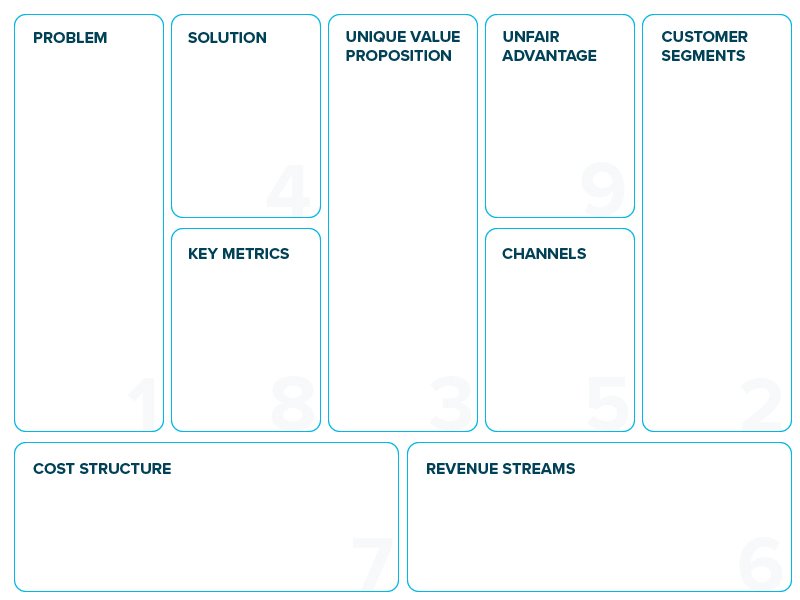Developing a concrete business plan helps your startup scale — but can slow you down in early stages. Here’s how to adopt the Lean Canvas method at pre-launch stages to boost your business agility.
How does the Lean Canvas help? One of the most important tasks an entrepreneur must complete before launching a new business venture is taking ideas that exist only as rough mental plans and writing them down in a format that communicates them to others.
The traditional approach to new business strategy is to compose structured, well-researched business plan. Composing a comprehensive business plan, however, can take weeks or months. The fast-moving nature of the modern startup environment requires agility speed — necessitating the creation of a new business plan model that can be developed and deployed quickly.
The Lean Canvas is a business plan model that helps entrepreneurs rapidly formulate and refine business concepts, develop product launches, identify target markets, and establish key differentiators. Importantly, the Lean Canvas helps entrepreneurs communicate with key stakeholders, functioning as a visual guide that transmits the core model or idea of a business concept in an efficient manner.
What is a Lean Canvas?
A Lean Canvas solves the biggest problem presented by business plans — they can absorb a significant amount of time and effort that can, in many cases, be better spent elsewhere. A well-researched comprehensive business plan is important at the right stage of a new business but is best executed at a growth or investment stage.
The core goal of the Lean Canvas methodology is to eliminate wasted time, inventory, and processes, creating an actionable business plan in the most efficient manner possible. The Lean Canvas allows entrepreneurs to get ideas out of the mental space and written down quickly.
A major advantage of the Lean Canvas is the speed with which it allows founders to communicate their ideas. A Lean Canvas is a distillation of your product or service, functioning as a simple, streamlined, single-page business model that can deliver your core concept within 30 seconds.
The use cases of the Lean Canvas aren’t limited to planning and structuring — a Lean Canvas can be used to pitch investors, update team members, or provide insight to a board.
What Does a Lean Canvas Look Like?
A Lean Canvas consists of 9 blocks, each of which complements the structure, purposes, and requirements of a Lean Startup approach. If you’re not familiar with the Lean Startup, take a look at Fullstack’s deep dive into Eric Ries’ work via The Lean Startup: Get Better Progress with your Product.
The Lean Canvas format is a one-page brainstorming model that guides entrepreneurs and startup founders through a series of local steps, beginning with the identification of customer solutions to quantifying the unfair advantage of your business model.

Lean Canvas Blocks Step-By-Step
Each of the 9 blocks of the lean canvas helps startup founders quantify key elements of a lean startup. Here’s how they work:
1. Problem
The first section you’ll address when composing a Lean Canvas is the Problem section. Each customer segment you plan on bringing a product or service to market with will have a set of problems that your product or service must solve.
The Problem box should detail a series of high-priority problems that your target customer segment has. By identifying a key problem to solve, you’ll be able to refine the product or service you want to offer.
2. Customer Segments
The Customer Segments box on the far right of the Lean Canvas mirrors the Problem box — without a specific customer segment in mind, it’s impossible to identify their specific problems, and vice versa. Both the Customer Segments and Problem boxes can be filled in at the same time, focusing on a key customer segment and their unique problems.
3. Unique Value Proposition
The middle of the Lean Canvas format is dominated by the Unique Value Proposition, or UVP, or your startup. A Unique Value Proposition represents the primary reason your Customer Segment will invest in your goods or services and presents the promise of value that you will deliver.
A simple way to understand your UVP is as the key reason why your startup is better or different, and why your Customer Segment will choose to purchase the goods or services you offer over those offered by your competition.
Testing the value of your value proposition is critical. A robust value proposition should present three key elements:
- Relevancy: your value proposition should explain, in a concise manner, how your product is able to solve the problems of your customer segment or improve their situation
- Quantified value: your value proposition should deliver specific benefits with relatable examples
- Differentiation: Your customer segment should be provided with a compelling reason to buy products or services from you, not from your competition
Your readers should be able to understand your value proposition at a glance — it’s important to write your value proposition in the same language your customer segment uses, joining a conversation that is already active within the mind of your CS. In order to learn the language of your customer segment, it’s essential to interview your customers.
For more details on the importance of a Unique Value Proposition and how to differentiate your startup, see the Fullstack guide on Differentiated Strategy: Building Competitive Advantage.
4. Solution
The Solution box is the product of all three prior segments in the Lean Canvas workflow. It’s likely that you will repeatedly revisit and refine this section, as it’s rare to assemble a complete solution outright. The Lean Canvas methodology is designed to be adaptive, so it’s fine to edit and change your solution as needed.
The most important function of the Solution box is to get your idea down on paper — a task that is best completed by taking your idea out of the building, and onto the streets, where your Customer Segment lives. Interview your Customer Segment, ask questions, and integrate their answers into your solution through a perpetual cycle of building, measuring, and learning.
5. Channels
Channels are the methods you use to get in touch with and connect to your Customer Segment. When identifying channels, it’s important to keep in mind the fact that you’re focusing on learning and refining, not scaling.
Your Channels box should focus on quantifying the channels that will give you sufficient exposure to your Customer Segment while allowing for feedback generation that drives your learning process. Channels can include social media, email campaigns, CPC ads, trade shows, blogs, radio and TV, or webinars. You don’t need to be present across all channels — just the ones where your Customer Segment can be found.
6. Revenue Streams
Your business model will determine how you will price your business. Many startups choose to lower the cost of the goods or services they offer. In some cases, startups may offer access to services for free in order to capture market attention or gain traction. This practice, however, can cause a number of problems
Providing access to products or services for free at launch can delay or obstruct validation — it’s far easier to capture new users when the product you are offering is free than it is to capture new, paying customers. It’s important to carefully manage the perceived value of your product or service.
7. Cost Structure
The Cost Structure section should break down every operational cost that you will incur throughout the entire process of bringing your business to market. This can include the costs associated with building your website or landing page, the cost of generating research papers, or your burn rate — your cumulative monthly operational cost.
It’s essential to quantify your costs and compare them to your potential revenue streams in order to calculate your break-even point.
8. Key Metrics
Every startup, regardless of size or industry, will operate according to a range of key metrics that can be used to monitor and assess performance. The most efficient means of identifying key metrics is to visualize a funnel model that encompasses five major elements — acquisition, activation, retention, referral, and revenue.
The wide top end of your metrics funnel will focus on acquisition, ranging downwards and narrowing in scope towards revenue at the bottom. Identifying the key metrics that drive your business will allow you to set goals and track progress towards them in future.
9. Unfair Advantage
The Unfair Advantage section is often the most difficult block to fill. The unfair advantage of your business should be the only competitive advantage you possess that can not be copied, purchased, or transferred.
An unfair advantage can be a highly effective go to market strategy, existing customers or users, endorsements from industry experts or thought leaders, a unique and original product or service that can’t be brought to market by anybody else, or highly effective team members.
When identifying your unfair advantage, avoid adding advantages such as “commitment and passion” — anybody launching a new business has this. What you’re looking for is the one element that only you have, that can’t be bought elsewhere.
What Should Your Completed Lean Canvas Look Like?
Your Lean Canvas should be completed in under 30 minutes. Some startup leaders choose to project the Lean Canvas framework onto a wall or whiteboard, using sticky notes to fill specific sections. Others choose to sketch out Lean Canvas business model ideas in a notebook.
Regardless of the method you use to compose your Lean Canvas, the core focus of your efforts should be to test and refine. Creating as many iterations of your first Lean Canvas draft as possible and subjecting each to rigorous testing will result in the emergency of a highly effective, winning business model.
Lean Canvas Key Takeaways
As a startup founder or entrepreneur, your primary goal at pre-launch states is to take the complex ideas you’ve developed out of your head and get them on paper. This allows you to communicate your ideas to others and recruit their assistance in building a solution to the problems of your customer segment.
Traditional business plans are extremely useful in many use cases but are largely irrelevant in the early ideation stage. Composing a business plan takes too much time — early stage business plans are often created without any validated data or refinement.
A business plan is best composed when your business has launched, is operational, and you’re seeking to scale. The early ideation stage of your business should stay lean — the Lean Canvas allows you to jot down concepts, test your hypothesis through lean principles, and capture feedback from your customer segment.
Launching a new startup or business is a complex process — in addition to lean canvas modeling, it’s essential to take factors such as business structuring and tax strategy into account. If you’re in the process of launching a new business, reach out to Fullstack for comprehensive guidance today.
Was this article helpful?
Related Posts
- Lean Market Validation
Learn how to determine whether there is a willing market for your product cost-effectively.
- A Guide To Estate Planning For Business Owners
As fun as business may be, it is important to consider how a business may…
- Small Business Grant
Been hiring recently? You’ll be pleased to note that the NSW government is keen to…
- Crypto Trading as a Business 101
Cryptocurrency trading as a business in Australia can deliver some impressive benefits. Do you qualify…
















